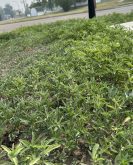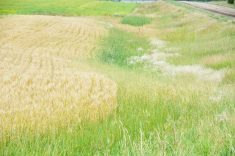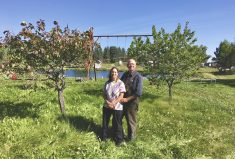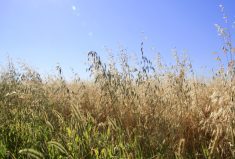Time’s just about up.
Crop growers won’t be able to spray their way out of problem weeds for much longer if herbicide resistance continues to spread, says one of the country’s top weed scientists.
“We’re seeing multiple-herbicide resistance show up in a few different weed species on the Prairies,” said federal research scientist Charles Geddes. “The number of herbicides we have to manage these biotypes are dwindling, and we need to come up with more creative approaches to help manage these biotypes effectively.”
Read Also

Roundup retraction makes public trust ripples
A foundational study on glyphosate safety was recently retracted, while Roundup maker Bayer has already said it may ditch the key agricultural herbicide after lawsuits piled up.
Canada is No. 3 in the world when it comes to herbicide-resistant weeds, with about 75 unique species resistant to certain herbicide modes of action, Geddes said at Farming Smarter’s recent virtual field school. Alberta is No. 2 in the country, with 26 resistant weed biotypes.
Managing these weeds coupled with reduced yield costs producers around $13 an acre.
“About 35 per cent of the farmland cropped in the Prairie region contains at least one herbicide-resistant weed biotype,” he said. “The most recent estimate is that herbicide-resistant weeds cost Prairie farmers about $530 million annually, which equates to a fairly large impact on the Prairie and Canadian agricultural sector.”
Wild oat is the biggest headache for Alberta growers with the most recent survey (from four years ago) finding more than half the fields having Group 1-resistant wild oat, and Group 2 resistance increasing as producers rely more on those herbicides.
“Essentially, all of these types of resistance are fairly widespread across the Prairie region, making wild oat one of the biggest herbicide-resistant weed problems that Prairie growers have to deal with,” said Geddes.
Kochia is not that far behind.
“We consider all kochia populations found on the Prairies Group 2-resistant,” he said. “It’s at the point where it’s not even worth testing for resistance anymore.”
Glyphosate-resistant kochia was first found in 2011 and in just five years, half of the population of that weed in the province was resistant to the Group 9 herbicide.
“This is a very rapid spread of herbicide resistance,” said Geddes, adding that in 2017, dicamba (Group 4) resistance was also found in about 18 per cent of the populations.
“That made about 10 per cent of the population triple-resistant to Group 2 herbicides as well as Group 4 and Group 9.”
And there’s no saviour on the horizon.
“In the past three decades, we really have not seen a new herbicide mode of action released that would be used in Prairie agriculture,” said Geddes. “So we’re seeing an increase in the number of herbicide-resistant weed biotypes but a stagnation in the release of new herbicide modes of action available for their management.
“We need to come up with new ways to help manage these biotypes and also mitigate the selection for new types of herbicide resistance.”
One method is herbicide layering.
“It is using effective multiple active ingredients and herbicide groups to control the same weed at different application timings, using soil-applied products to control weeds while they are emerging and utilizing tank mix strategies to control already emerged weeds,” said Nolan Kowalchuk, technical sales manager at FMC Corporation.
An effective strategy limits the application of a single mode of action and the use of the same herbicide or tank mix repeatedly.
But producers must answer a few questions first, he said, including: What weeds are being targeted? What products or modes of action will offer the greatest efficacy? Do you have products that offer high control of resistant weeds? What application timing will control those target weeds?
“It’s answers to these areas that are critical in the approach you choose to manage resistance,” said Kowalchuk.
And in the case of layering, more is better.
“Use as many different herbicide groups as possible. Four would be great,” he said, adding that timing will play a role in how you layer.
“Ensure your pre-seed and in-crop herbicide applications include different chemical groups. This will ensure you do not select for resistance to another group or increase selection pressure to a group you may already have some resistance to.”
Pre-seed herbicides should offer extended control to help reduce weed pressure prior to the in-crop herbicide, he added.
“Utilizing an extended-control herbicide-layering product will be key in controlling these early flushes, not only reducing weed pressure for the in-crop but allowing one to pick an in-crop that is better suited for what new weeds may emerge,” he said.
And there’s no cookie-cutter approach.
“There’s no silver bullet answer or strategy that will work for all,” said Kowalchuk. “However, proactive planning will allow you to develop a practical working strategy for helping prevent herbicide resistance from developing or being able to actively manage it if it has already developed.”















